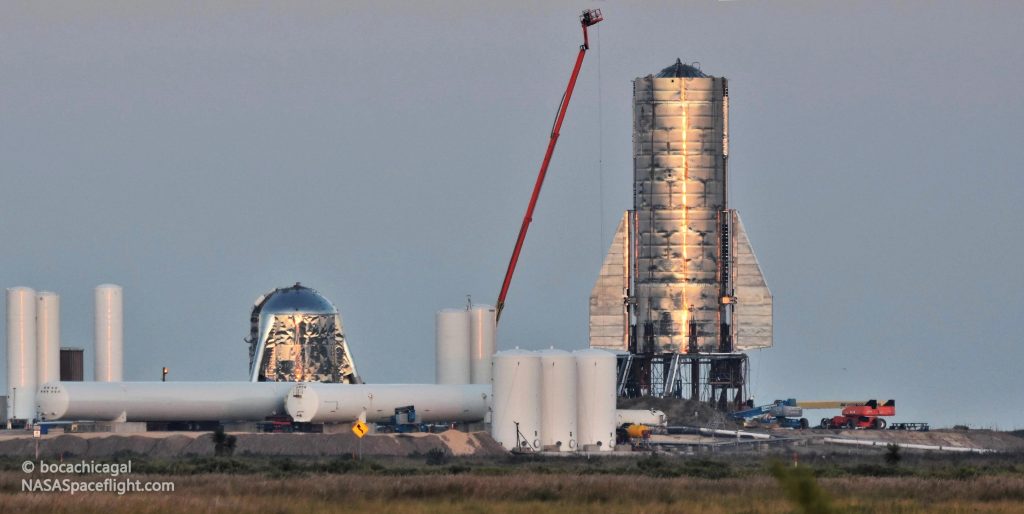For the first time ever, SpaceX has pressurized Starship Mk1’s building-sized propellant tanks, a critical test that culminated in the rocket prototype essentially taking its first ‘breaths’.
An anthropomorphization sometimes used to describe the venting launch vehicles often exhibit while during and after fueling, Starship Mk1’s so-called ‘breaths’ occurred around 5:59 pm CST (23:59 UTC). Those first vents came after roughly an hour or two spent performing several different pressurization cycles, observable due to the fact that Starship’s stainless steel tanks visibly smoothed out as pressure increased.

Due to the typical distances Starship is viewed from and the nature of the mirror-finished stainless steel SpaceX has chosen to build the next-generation launch vehicle out of, the exterior of Starship prototypes can produce a reflection that looks bumpy and disjointed. This has lead many a layperson to incorrectly assume that SpaceX’s Starship prototypes are thus shoddily built. In reality, viewed from afar, the tiniest hint of surface heterogeneity on a mirror can dramatically change what is reflected on its surface.
Even at the thinness of Starship Mk1’s liquid oxygen and methane tanks, stainless steel is still extremely strong, but pressurizing the vehicle’s tanks can clearly counteract a significant portion of the slight imperfections in their curvature.
Although it’s now clear that SpaceX did in fact perform some kind of pressurization test with Starship Mk1, it remains to be seen what exactly the nature of that testing was. First and foremost, SpaceX did establish significant roadblocks almost six hours before testing began, and company workers vacated the launch site several hours before visible Starship pressurization and venting. Fairly soon after that vent, workers returned to the pad and may or may not have been present during additional (but more subdued) venting activity.
Most importantly, November 18th’s testing featured a sum total of zero visible activity at SpaceX’s nearby flare stack, a mechanism used to burn waste methane gas to prevent dangerous buildups at worksites (or launch pads). This almost certainly means that methane (gaseous or liquid) played no role in pressurizing Starship Mk1’s propellant tanks.

Altogether, that likely means that Monday’s proof test was not a wet dress rehearsal (WDR), a term used to describe the process of testing a launch vehicle by fully fueling it and performing a countdown identical to a real launch – but without engine ignition or liftoff. Instead, SpaceX likely began the day’s testing by pressurizing Starship several times with a neutral gas like nitrogen or helium, while gaseous oxygen is also a possibility but is significantly less likely. Simply by using pressure sensors on Starship and knowing the volume of gas that is being loaded, SpaceX could likely determine whether the prototype has any leaks.
The major vent around 6 pm local time could have simply been Starship venting that pressurant gas, which would explain why there was just a single large, observable vent. When dealing with cryogenic liquid propellant, those supercool liquids gradually heat up, causing a portion to boil and turn into gas, gas that launch vehicles then vent intermittently to prevent overpressure events (i.e. explosions). Starship Mk1 only visibly vented once, although there may have also been some additional venting even after technicians returned to the launch site (another sign that the pressurant was neither toxic or combustible).

Oddly, shortly after SpaceX workers returned to the launch pad, they appeared to begin spraying down Starship Mk1 with a large volume of water or foam, producing clouds of mist as large as Starship itself. This came as a total surprise and why it’s being done is entirely unclear. Possible explanations include simply rinsing Starship (but why and why now?), checking its tanks for leaks, applying industrial quantities of WD40 (used to protect stainless steel from rust), or maybe even testing how Starship stands up to ice (extremely unlikely as it would need to be filled with a cryogenic liquid to be cold enough).
Perhaps the morning light will bring some answers. All things considered, as long as the mysterious spraying is not indicative of any serious issues or concerns with Starship Mk1, SpaceX may now be ready to put the prototype through a true propellant loading test, potentially filling its tanks with as much as 1200 metric tons (2.65 million pounds) of liquid oxygen and methane. If or when Starship passes that test, it’s next trial will be the very first triple-Raptor-engine static fire test. For now, we wait.
Check out Teslarati’s newsletters for prompt updates, on-the-ground perspectives, and unique glimpses of SpaceX’s rocket launch and recovery processes.

(adsbygoogle = window.adsbygoogle || []).push({});
<!–
–>
var disqus_shortname = «teslarati»;
var disqus_title = «SpaceX’s Starship comes to life for the first time in lead-up to launch debut»;
var disqus_url = «https://www.teslarati.com/spacex-starship-comes-to-life-launch-debut-lead-up/»;
var disqus_identifier = «teslarati-120898»;

